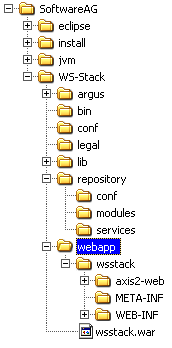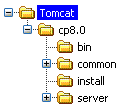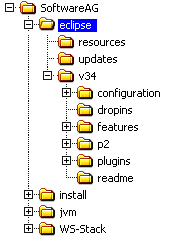The information is organized under the following headings:
This folder contains the Web Services Stack program files.
The WSS installation creates the following directory structure:

The table below lists the contents of each folder.
| argus |
The binary files and other resources needed by Web Services Stack Argus agents |
| bin |
The batch files that facilitate the usage of Web Services Stack command prompt utilities; for example, axis2.bat, axis2server.bat, java2wsdl.bat, wsdl2java.bat, etc. |
| conf |
The configuration file needed for the stand-alone server |
| lib |
All the third party libraries and libraries owned by Software AG that are needed for running, building, and developing of web services artifacts (clients and services) |
| miscellaneous |
This directory contains all modules that have experimental or optional status and are not deployed by default. To use the content of the module, copy it manually into the Web Services Stack web application or into the Axis 2 “repository” that is in use by a given client. For example, the Kandula2 module and the needed libraries are stored into the miscellaneous folder. |
| repository |
The binary files and text configuration files that are needed on the client side and are spread in separate subdirectories |
| repository\conf |
The configuration files needed to run the WSS client applications |
| repository\modules |
The Web Services Stack modules that provide additional functionality to the engine; for example, security, reliable messaging, etc. The modules are packed into Java archives and bear the MAR file extension (MAR = module archive). |
| repository\services |
The web services either packed into Java archives bearing the AAR file extension (AAR = Axis archive) or in an expanded directory structure Note: |
| webapp |
The Web Services Stack web application and a packed WAR file (wsstack.war) for an installation in a custom web application container |
This folder contains the deployed web application in the webapp directory of the Tomcat kit (or Apache Tomcat).
The WSS installation creates the following directory structure:

The table below lists the contents of each folder.
| axis2-web |
The web resources: *.jsp, *.css, and *.inc files |
| META-INF |
The MANIFEST.MF file for the web archive |
| WEB-INF |
The core parts of the Web Services Stack engine in separate sub-folders and the web.xml (web application configuration descriptor file) |
| WEB-INF\classes |
Any supporting Java classes needed for the proper operation of a deployed web service |
| WEB-INF\conf |
The configuration files |
| WEB-INF\lib |
All Java libraries needed by the Web Services Stack engine |
| WEB-INF\modules |
The modules that provide additional functionality to the engine; for example, security, reliable messaging, etc. The modules are packed in Java archives and bear the MAR file extension (MAR = module archive). |
| WEB-INF\services |
The web services either packed in Java archives bearing the AAR file extension (AAR = axis archive) or in an expanded directory structure |
For additional information on deployment, see Deployment of the Runtime
Note:
On Windows, unlike the Apache Tomcat distribution, the Tomcat kit
installs the Tomcat files at two locations. The following screen captures
illustrate the installation locations:
\Documents and Settings\All Users\Application Data\Software AG\Tomcat

\Program Files\Software AG\Tomcat

Note:
The locations of the configuration files of the Tomcat kit can
co-exist with a standard installation of Apache Tomcat server.
Software AG Eclipse Package (SEP) creates the \SoftwareAG\eclipse folder.
This folder contains the installed Software AG Eclipse plug-ins.

For more details on how to install and use the Web Services Stack Eclipse plug-ins, see Eclipse Plug-in.
The version number of the particular update package is a three-digit number which depends on the version of the current installation. You can construct the version number using the version of the release (omitting any periods in the number) and the SP version (using the number of the SP release). For example, if you want to update a Web Services Stack 8.0 SP4 installation, the version number of the update package is 804, and the file name is: eclipse.wss.804.UpdatePackage.0000.zip.
Note:
You can use
eclipse.wss.version_number.UpdatePackage.0000.zip
and com.softwareag.common.zip under the
\SoftwareAG\eclipse\updates folder for installation of the
Web Services Stack Eclipse plug-ins in another Eclipse distribution. The
version number of the particular update package is a three-digit number which
depends on the version of the current installation. You can construct the
version number using the version of the release (omitting any periods in the
number) and the SP version (using the number of the SP release). For example,
if you want to update a Web Services Stack 8.0 SP4
installation, the version number of the update package is 804, and the
file name is:
eclipse.wss.804.UpdatePackage.0000.zip.